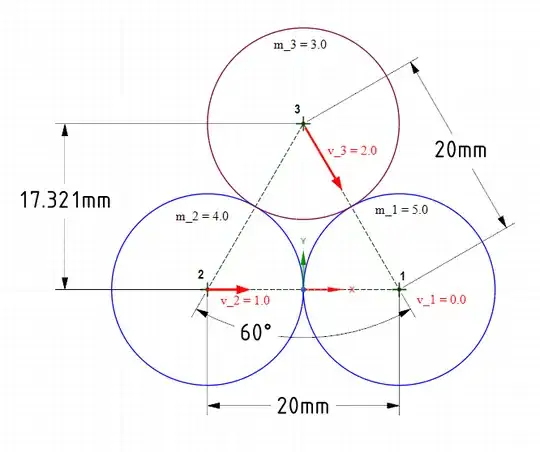I have written an algoritm to resolve a collision between two balls with conservation of momentum. It looks to work exactly as expected in my simulations. Here is the code:
public void Resolve()
{
var r = 0.5; // coefficient of restitution
var m = Ball1.Mass + Ball2.Mass;
var ua = Ball1.Velocity.Magnitude * Math.Cos(Ball1.Velocity.Angle(Normal));
var ub = Ball2.Velocity.Magnitude * Math.Cos(Ball2.Velocity.Angle(Normal));
var va = (r * Ball2.Mass * (ub - ua) + Ball1.Mass * ua + Ball2.Mass * ub) / m;
var vb = (r * Ball1.Mass * (ua - ub) + Ball1.Mass * ua + Ball2.Mass * ub) / m;
Ball1.Velocity -= Normal * (ua - va);
Ball2.Velocity -= Normal * (ub - vb);
}
Now I also want to make this work for more than two balls colliding at the exact same moment. My initial thought was that I could just solve this equation several times for each contact between balls. When I have a situation like a "Newton's cradle" where the balls is in contact in a "serial" way it's easy to just solve each collision on at a time and without moving the balls just go ahead and calculate the next and the next etc until reaching the last ball which will end up with all energy not lost along the way. This works fine also, albeit not very fast.
But what about for instance a case where three balls are in contact in a V-shape and the bottom ball is the one with a velocity (up in this case)? I mean how now do I distribute the energy between the other two balls? The equation I have only works for two balls and now I don't see how I can calculate this iteratively anymore. Can you help guide me in how I should think with this? Can I modify my Resolve-function to work with any number of balls? I mean with a set of $N$ balls with connecting surfaces and initial velocity vectors, what will the outcome velocities be? Is there a well known general solution for this?
Note:
I have tried out the method currently marked as the answer but I have unfortunately got a bit weird results in some setups. Be warned. I will probably revert back to resolving one collision at a time again. I will update this info when I have tried this more.
